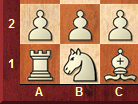|
Chess notation |

|

|
|
|
Chess notation |

|

|
Chess notation
One of the most important factors in the advancement of chess knowledge was the invention of a efficient notation to describe moves. It is done with the help of piece names, eight file letters (a – h) and eight rank numbers (1 – 8).

In long algebraic notation you use the piece letter, followed by the start and destination squares. Example: 1.Ng1-f3.
In short algebraic notation you use only the destination square whenever possible. Example: 1.Nf3, because only the knight on g1 can move to f3. If there is an ambiguity you have to supply an additional letter or number. Example: 5.Nbd2 if two knights can move to d2, one from b1 and one from f3. If the knights are on b1 and b3 you would write N1d2.
Pawn moves are given without a letter for the pawn. Example: 1.d2-d4 or 1.d4
Captures are denoted with an "x". Example: 3.Nf3xd4 or 3.Nxd4.
Checks are marked with a "+", checkmate is "#".
You can switch between long and short algebraic notation in the Menu File – Options – Notation.
To switch on the coordinates right-click the chessboard and select Board design. Click coordinates on or off.